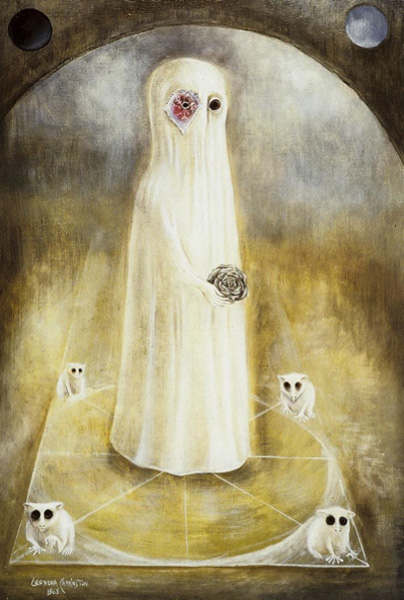The Ancestor by Leonora Carrington (Interpretation and Analysis)
 |
| The Ancestor Source: Museo de Mujeres |
Carrington was a visionary, both literally and figuratively. She reported that she often had visions of ghosts and animals when she was a child; these memories undoubtably impacted her adult work. As well as being a visual artist, Carrington was also a writer, and her art often illustrated or referred to the fantastical concepts that emerged from her writing.
Her history with ghosts might come into play in her 1968 painting The Ancestor. The painting depicts a spectral figure dressed in a sheet and standing in the midst of a white circle. Around the edge of the circle, strange, ghostly animals gaze out at the viewer with empty, black eyes. The ghost itself has one empty eye socket and one eye surrounded by a red and white decoration.
While it’s tempting to find The Ancestor charming or comical, there is a level of seriousness behind the painting that belies lighthearted humor. The ghostly figure in The Ancestor can be seen as a kind of talisman, a protective spirit that guards its descendents. Many cultures around the world seek guidance or help from departed family members, and it’s possible that Carrington was trying to tap into this tradition when she created The Ancestor. The circle that the ghost stands in suggests some sort of magical influence as well. This sort of ritualistic magic is a major theme in Carrington’s work. Like many Surrealists, she was interested in exploring the liminal spaces in the human psyche. Carrington often did this through magical imagery. The Ancestor, for example, borrows stylistic and compositional elements from religious imagery and icons; you can almost think of it as a Surrealist altarpiece. The ghost figure itself has a chilling anonymity. Although it can be understood as a universal figure—standing in for all the ancestors throughout time—the ghost’s blank, expressionless face communicates something more mysterious and unfathomable to me.
It’s also possible that Carrington was responding to recent happenings in Mexico when she created The Ancestor. In an essay about Leonora Carrington, writer Angélica Abelleyra posits that Carrington painted The Ancestor in reaction to the political and social turmoil in Mexico at the time. Abelleyra notes that The Ancestor’s companion painting, an untitled piece of art, includes the following text painted into the background:
By the river of Yggdrasill, there we sat down, yea we wept because they are murdering our sons, our daughters, the birds and the fishes and trees of the earth. We hanged our harps upon the willows in the midst thereof for they that carried us away captive required of us songs—they that wasted us required of us mirth.As Abelleyra points out, this text—which is based on a biblical psalm—seems to reference the Tlatelolco Massacre, a student-led protest that ended in bloodshed when the Mexican military opened fire on the crowd.




Comments
Post a Comment